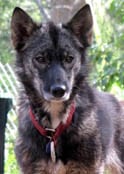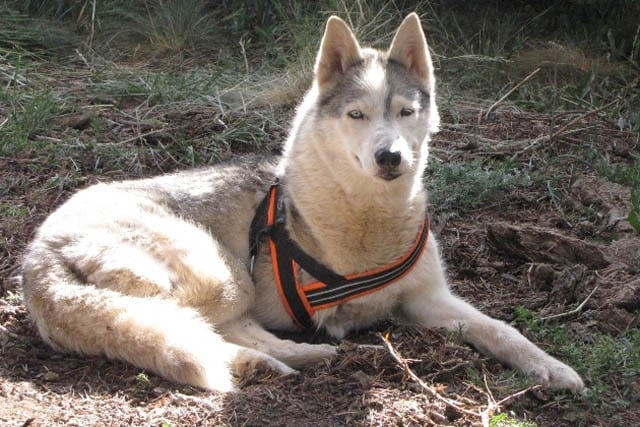The following Guest Blog Post was generously written by Calpurnia’s Mom, TC Wait. To submit your own guest post to Tripawds, contact us today.
 I have always been somewhat uneasy with the thought of chiropractic practice. Somehow the thought of someone manipulating my spine just gives me the willies. I am the first to admit, however, that I don’t know much about it, so when my Aunt told me she was using a canine chiropractor for her rescued greyhounds, I decided to educate myself about it. The world of veterinary medicine is continually evolving and with that evolution, holistic practices are also becoming more frequently found. Maybe my dogs, including my tripawd Calpurnia, would get some benefit to adding chiropractic work into their health care.
I have always been somewhat uneasy with the thought of chiropractic practice. Somehow the thought of someone manipulating my spine just gives me the willies. I am the first to admit, however, that I don’t know much about it, so when my Aunt told me she was using a canine chiropractor for her rescued greyhounds, I decided to educate myself about it. The world of veterinary medicine is continually evolving and with that evolution, holistic practices are also becoming more frequently found. Maybe my dogs, including my tripawd Calpurnia, would get some benefit to adding chiropractic work into their health care.
I did some online research and found Dr. Debbie O’Reilly, who has been adjusting animals since 1996 and is certified by the American Veterinary Chiropractic Association. Dr. O’Reilly is also a practicing human chiropractor and runs the Vibrant Energy Healing Center in Littleton, CO. She was happy to answer my questions, and even came to our house to evaluate a dog that was having some issues.
Pika is a new dog to our pack. She has been showing some weakness and poor gait on the right side (both front and rear legs) that my vet and I have thought may be related to an old neck injury (possibly from a rough birth or something). Poor Pika was coping as best as she could, but when it came to pulling in harness (something she LOVES to do), her gait definitely showed signs that she became painful from it.
In addition to Pika, I had targeted our front leg amputee, Calpurnia, as a potential for chiropractic work, since she is getting older (she is going on 14 now) and front leg amputees are sort of forced to rotate the good shoulder down to walk. That has to have some sort of spinal implication. I decided to have work done on Pika first, since some dogs are sore for about 24 hours after an adjustment. I figured being sore when you are 2 years old on 4 legs would be easier than being sore when you are 14 and on 3 legs.
Dr. O’Reilly arrived at our house and patiently answered more of my questions. She then introduced herself to Pika, who is pretty shy. I was surprised at how Pika seemed to understand that Dr. O’Reilly was there to help, and since I think that you can tell a lot about a person from how animals react to them, this was a good thing. After watching her gait and stance, Dr. O’Reilly was able to determine a couple of areas that she thought were not aligned correctly and went about doing an adjustment.
The adjustment itself was pretty quick. Dr. O’Reilly started at Pika’s pelvis and used her hands to move up the spine, vertebrae by vertebrae, testing the alignment and flexibility of each joint. In places that were out of alignment, she used a firm pressure to bring them back to alignment. She did this all the way up to the back of Pika’s neck. It was hard to really see what she was doing because it was so fast!
After the treatment, Pika needed to remain quiet for about 24 hours. No running, playing, or jumping. This is to help keep the corrected alignment in the spine, and also because she might have some muscle soreness following the treatment, sort of like after a deep-tissue massage. Some dogs will need a pain reliever or arnica post-treatment to help with the soreness (the chiropractor will tell you what to do). Pika would need to have a follow-up treatment, possibly including some acupuncture work, in 2 weeks, then probably monthly after that.
I asked Dr. O’Reilly about adjusting Calpurnia, who is a natural busy-body and felt she needed to be involved “assisting” with Pika’s treatment. Dr. O’Reilly felt Cali’s spine for a bit, then laughed and said “Calpurnia is FINE. There is nothing wrong with her spine.” Apparently, whatever spinal twisting is going on with Cali’s missing leg is not causing any incorrect vertebrae alignments. Dr. O’Reilly was impressed at how well Cali was doing and attributed her good health and agility to her overall physical condition and light body weight. All those years of running on a sled have had a good long-term effect on the old girl.
So, here are some tips and thoughts for other “Chiro-Newbies” that may be considering a canine chiropractor that I learned through this experience.
- A canine chiropractor can be considered anytime a dog is not performing at 100% (seems out of sorts or just not “their normal self”, reacts to petting, starts holding up a paw, standing not quite right or holding their head off to one side, or anytime the dog has been involved in a accident either due to play or work). Typical issues that Dr. O’Reilly is asked to help with include “everything under the sun” ranging from injuries, post surgical care, and limping/lameness, to lick granulomas, sloppy sitting, and internal medicine disorders. Canine chiropractic works hand-in-hand with veterinary medicine. Sometimes Xrays or drugs are necessary as well as physical therapy.
- When looking for a canine chiropractor, there are a couple of things to keep in mind. An animal chiropractor can only be a chiropractor or veterinarian certified in animal chiropractic. The American Veterinary Chiropractic Association certifies all veterinary chiropractors. The website lists their certified doctors by state. There are many people out there calling themselves animal chiropractors, but they are not vets or chiropractors and have not gone through the AVCA approved programs. I have heard some horror stories about crippling injuries stemming from chiropractic treatments gone wrong, so I would recommend doing your research before letting a doctor adjust your dog (or yourself). In Colorado, canine chiropractors also need to be licensed by the state.
- Some animal chiropractors offer other holistic treatments that you can ask about. Dr. O’Reilly also has a Diplomate in acupuncture, does massage and swim therapy, and can use “muscle testing” to check for allergies and recommend supplements.
At Pika’s follow-up exam, Dr. O’Reilly was happy that progress had been made in her spine. I had been noticing that Pika was using her back leg more effectively around the yard. Dr. O’Reilly did some acupuncture in Pika’s lower back, followed by another chiropractic adjustment. We will do follow-up treatments monthly through the start of our fall training to see how she is progressing.